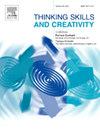培养大学生学习和个人成长的课程空间:来自STEM项目顶点演讲的证据
IF 4.5
2区 教育学
Q1 Social Sciences
引用次数: 0
摘要
目的本研究考察了一所以健康科学为重点的大学本科高年级学生的学习过程。在他们的顶点课程中,学生设计个性化的最后一年课程,进行结构化的反思,并公开展示他们的学习成果。应用课程空间模型(Blasco, 2016),该模型结合了日本的ma概念,这是一种促进学习的有意差距,我们探索了三个课程空间(认知、自主和反思)之间的相互作用对Capstone期末报告中创新和创造性思维的影响。方法采用反思性主题分析和内容分析的方法,分析了74个演讲视频(占2017-2022年Capstone演讲的15%),其中包括42个杰出的演讲和32个随机选择的演讲。结果学生的报告揭示了六个主题,揭示了课程空间对学习的影响:(1)幽默地呈现挑战,(2)移情讲故事,(3)顶点前后,(4)真相陈述,(5)详细的关键事件,以及(6)承认作为一种反思模式。内容分析显示,三个代码(“不寻常的”、“脆弱的”和“感官的”)与大多数其他代码高度相关,强调这些代码是中心重要的学习现象,并进一步确定了“脆弱”和“真实性”之间的特别强的联系。在显著和非显著顶点表现之间没有发现显著差异。我们的分析显示,个人成长和身份发展是顶点演讲的主要学习成果,这是通过优先考虑反思和想象的空间,并通过创造性的、真实的自我表现来表达的。本文章由计算机程序翻译,如有差异,请以英文原文为准。
Curricular spaces of ma 間 for cultivating undergraduate learning and personal growth: Evidence from capstone presentations in a STEM program
Aim
This study examined learning processes in the context of a Capstone program for undergraduate seniors enrolled in a health sciences-focused university. During their Capstone, students design a personalized final-year curriculum, engage in structured reflection, and publicly present their learning. Applying the curricular space model (Blasco, 2016) which incorporates the Japanese notion of ma, an intentional gap that facilitates learning, we explored the impact of the interplay between three curricular spaces (cognitive, autonomy, and reflection) on innovative and creative thinking in Capstone final presentations.
Method
Using reflexive thematic analysis and content analysis, we analyzed 74 presentation videos (15 % of Capstone presentations from 2017–2022), including 42 distinguished presentations and 32 randomly selected ones.
Results
Student presentations revealed six themes that shed light on the impact of curricular space on learning: (1) Humorous presentation of challenges, (2) Empathetic storytelling, (3) Pre- and post-capstone, (4) Truth statement, (5) Detailed critical incident, and (6) Acknowledgement as a mode of reflection. Content analysis revealed that three codes (“Unordinary,” “Vulnerability,” and “Sensory”) were highly connected to most other codes, highlighting these as centrally important learning phenomena, and further identified especially strong links between “Vulnerability” and “Authenticity.” No significant differences were identified between the distinguished and non-distinguished Capstone presentations.
Discussion
Our analysis revealed that personal growth and identity development were key learning outcomes in the Capstone presentations, which emerged through prioritizing reflective and imaginative spaces and expressed through creative, authentic self-representation.
求助全文
通过发布文献求助,成功后即可免费获取论文全文。
去求助
来源期刊

Thinking Skills and Creativity
EDUCATION & EDUCATIONAL RESEARCH-
CiteScore
6.40
自引率
16.20%
发文量
172
审稿时长
76 days
期刊介绍:
Thinking Skills and Creativity is a new journal providing a peer-reviewed forum for communication and debate for the community of researchers interested in teaching for thinking and creativity. Papers may represent a variety of theoretical perspectives and methodological approaches and may relate to any age level in a diversity of settings: formal and informal, education and work-based.
 求助内容:
求助内容: 应助结果提醒方式:
应助结果提醒方式:


